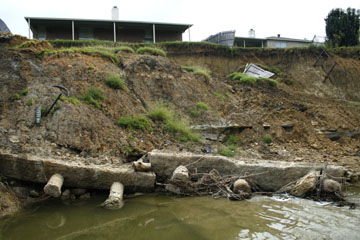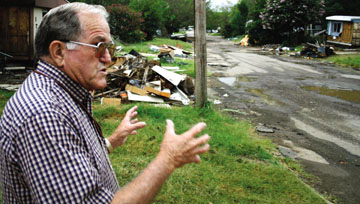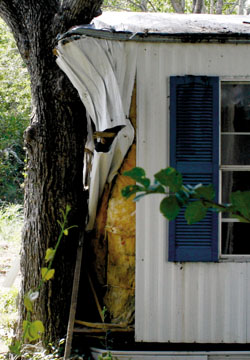When Natasha Collins thinks about her precious little girl these days, she doesn’t dwell much on the horror the two went through on that last night, in the early hours of June 18 — the water rising to five feet in their mobile home in just half an hour, the swirling water outside knocking her into fences as she clutched Alexandria, the feel of her daughter being ripped from her arms as another wave washed over them.
 Two hours later, Ally, as the family called her, was found lying almost peacefully in the leaves on a creek bank about a quarter mile downstream, her face to the sky. “She looked like she was in a manger,” Natasha said.Instead of those images, Natasha thinks about a 4-year-old so smart she corrected her mother’s grammar, a little sister who tagged around with big sis Chelsea, and, mainly, a kid who loved to laugh.Natasha and her husband, Aaron, are trying to move on. They have accepted Ally’s death — but not its cause. Their daughter drowned in Whites Branch Creek in Haltom City — a creek with a history of flooding going back decades, including a minor one as recently as April 13, a few weeks before the Collins family moved into the Skyline Mobile Home Park. The stream is part of the floodprone Big Fossil Creek watershed, where the U.S. Army Corps of Engineers has been studying flood-control plans since 1974. Studying — but not doing anything.
Two hours later, Ally, as the family called her, was found lying almost peacefully in the leaves on a creek bank about a quarter mile downstream, her face to the sky. “She looked like she was in a manger,” Natasha said.Instead of those images, Natasha thinks about a 4-year-old so smart she corrected her mother’s grammar, a little sister who tagged around with big sis Chelsea, and, mainly, a kid who loved to laugh.Natasha and her husband, Aaron, are trying to move on. They have accepted Ally’s death — but not its cause. Their daughter drowned in Whites Branch Creek in Haltom City — a creek with a history of flooding going back decades, including a minor one as recently as April 13, a few weeks before the Collins family moved into the Skyline Mobile Home Park. The stream is part of the floodprone Big Fossil Creek watershed, where the U.S. Army Corps of Engineers has been studying flood-control plans since 1974. Studying — but not doing anything.
There’s a long list of reasons — or, depending on your point of view, excuses — why nothing’s been done: funding problems, the need for studies, other projects moving ahead of Haltom City in the line for the Corps’ help, hurricanes, the need for more studies, diversion of federal funds to war, and bureaucratic paper-shuffling. Another study is due out at the end of this month. “After Ally died — gee, after all of us almost died — I started to do some research,” Natasha Collins said. “This has been a problem for a very long time, and they have identified it as a flood problem. They always say they don’t have any money. But it really makes me wonder when I look at that lake they are going to build in Fort Worth [the Trinity River Vision “town lake”]. They found over $100 million for that in just a few years. All I know is that some of this could have been prevented.”
The record rains and the summer floods have many in Haltom City coming to the same conclusions. Little Fossil Creek, which flows through the heart of Haltom City, and Big Fossil, into which it empties, and which forms part of the boundary between Haltom City and North Richland Hills, are being overwhelmed repeatedly by floodwater they can no longer handle within their channels. Part of the reason is the thundering pace of development to the north and northwest, in the headwaters of those creeks. Huge stretches of grassland and trees that once allowed rainwater to percolate down gradually to aquifers and creeks have now been covered by concrete and asphalt, sending the water directly into storm sewers and then quickly into the creeks, according to Corps studies. The creek channels haven’t been widened, but the water pouring into them has grown exponentially. And so during heavy rains, they turn into dangerous, fast-running rivers, far out of their banks.
That’s where the Collins family was on the night of June 17. The trailer they’d moved into in May sat about 30 feet from the creek. At 11 p.m., when Natasha and Aaron were still up, they saw that the water was about ankle-deep outside their trailer, but the rain had stopped by then, so they didn’t worry about the water rising higher. Ally, 10-year-old Chelsea, and Chelsea’s friend who was spending the night were all asleep. The problem for Skyline Mobile Home Park, however, wasn’t the 2.6 inches of rain that had fallen in Haltom City. It was the rain that kept on falling upstream, in Keller and the Alliance Airport area, to a total of five inches. That was the water barreling downstream to Haltom City. Around 1 a.m., the Collinses realized that water was inside the house and awakened the kids to get them dressed to leave. But then things started happening fast. Within about 15 minutes, as they recall, the water rose several feet, cutting off most of their options for escape. By about 1:30 a.m. there was five feet of water inside the trailer, and it was seven feet deep outside.
Aaron, a maintenance worker who has training in scuba diving, found a rowboat floating in a neighbor’s yard and moved it toward their trailer. Bringing it to the trailer door, on the downstream side, would have pulled the boat from his grasp, so he swam it over to the upstream side, where the roiling creek waters pinned it against the trailer. Natasha and the girls broke a window to get out and managed to get into the boat. Within a few minutes, however, it capsized, throwing them all into the water. . Aaron, thrown free of the others, clung to a tree. Natasha tried to hold onto the three girls in water over her head, but soon lost Chelsea and her friend. She shouted for Aaron, and he swam into the rushing water and grabbed them, then moved the two girls to higher ground. But as Natasha held Ally with both of her arms close to her chest, another surge of water sucked them under, and Natasha found herself jammed against a chain-link fence. “I kept fighting, but my legs were wedged under the fence, and I just couldn’t hold her any more,” Natasha said. “When I got up to the surface, I yelled for Aaron to find Ally, and he swam everywhere. It just all happened so quickly.”
The Collins family now lives in a rented house in North Richland Hills. The Federal Emergency Management Agency provided $7,000 to help them get resettled. But Natasha wants more — not for herself but for Haltom City in the future. She thinks the former mobile home park, where about 50 of the homes were damaged beyond repair, would make a good park, named after her daughter. She also thinks a flood-warning system, with sirens that would go off after water hit a certain level, would be a first step. “This happened in the middle of the night when most people were asleep, so a warning system would have helped,” she said. “But they also need to fix this entire flood area. From everything I’ve read, it is just getting worse and worse. And no one is doing anything about it.”
Big Fossil Creek, with tributaries like Whites Branch and Little Fossil, drains a 76-square-mile watershed, starting north of Saginaw and running southeast through some of the fastest-growing parts of Fort Worth and Tarrant County. About half a million people have joined the county’s population since 1990 — and many of them have settled in the neighborhoods north of Loop 820. Every day seems to bring another subdivision, another row of rooftops marching across the prairie. A lot of this growth came during a period of drought, so the problem of floodwater runoff was not always on the front burner. But 2007 is setting all sorts of rainfall records. From January through July, almost 38 inches of rain fell at Dallas-Fort Worth International Airport, more than 16 inches above normal.
 But the rainfall north and west of Haltom City was even heavier. Alliance Airport recorded 43.59 inches through August, the highest in the region. At DFW Airport, 11 inches of rain were recorded in June, but Alliance got almost 15 inches. And when the rains are heavy in that part of the county, Haltom City is where the water has to go — the last town along the route before the creeks join the West Fork of the Trinity River near Airport Freeway. For years, the blue-collar suburb has concentrated more on keeping taxes low than on keeping up with the maintenance of its infrastructure: A recent study says the city needs to spend $103 million to bring its creeks and storm sewer system up to code. But even when the city has coughed up money for needed projects, the federal government has not. After 30 years of studies on Big and Little Fossil and Whites Branch, studies that confirmed serious flooding problems, nothing has been done.
But the rainfall north and west of Haltom City was even heavier. Alliance Airport recorded 43.59 inches through August, the highest in the region. At DFW Airport, 11 inches of rain were recorded in June, but Alliance got almost 15 inches. And when the rains are heavy in that part of the county, Haltom City is where the water has to go — the last town along the route before the creeks join the West Fork of the Trinity River near Airport Freeway. For years, the blue-collar suburb has concentrated more on keeping taxes low than on keeping up with the maintenance of its infrastructure: A recent study says the city needs to spend $103 million to bring its creeks and storm sewer system up to code. But even when the city has coughed up money for needed projects, the federal government has not. After 30 years of studies on Big and Little Fossil and Whites Branch, studies that confirmed serious flooding problems, nothing has been done.
So when Haltom City officials look a few miles to the west, their temperatures rise faster than the floodwaters. The Corps has found a way to commit $125 million to the Trinity River Vision project, which was first studied in 2001. By contrast, Haltom City voters approved a $4 million bond issue in 2001 for flood-control measures on Little Fossil Creek, but the Corps could never find the $6 million federal share to make it happen — this, despite identifying a dozen major floods on the creek since 1957, including a big one in 1981 that caused $10 million in damages (in 1981 dollars). And a lot of those dirty looks are being shot right at U.S. Rep Kay Granger, who represents both Fort Worth and Haltom City. “Because of congressional priorities, I guess our projects didn’t matter that much,” said Haltom City Councilman Richard Hutchison. “We always get knocked off the list by other projects, and it is exasperating because ours are real flood-control projects and [the TRV] really isn’t. It shouldn’t take a disaster to move us up on the list. … It seems we only move up on the list when we lose a life. That is what bothers me.”
Former Haltom City Mayor Jack Lewis puts it in even stronger terms. “Trinity River Vision is a downtown [Fort Worth] revitalization program with Granger backing it, and her son [J.D. Granger] is in charge, and in reality, Haltom City does not stand a chance when we are competing for federal dollars against a project like that,” he said. “And I don’t care how they try to sell it, [TRV] is not a flood-control project. The big dollars are in Fort Worth, and they get this huge amount of money for what they call flood control. But they don’t have the flooding — Haltom City does. So they get the flood-control money, and we don’t. The flooded areas in Tarrant County need to be addressed before projects like TRV even get to the table.” Clay Church, a public information officer in the Army Corps’ Fort Worth district, says it takes 23 years from the first study to finish the average Corps project. That is not a misprint.
Cathy Hiles, who has lived near Little Fossil Creek and Airport Freeway for several decades, isn’t surprised by that time frame. In Haltom City, she said, “I guess we are helping push the average even higher.” “We had a big flood in 1990, and the residents and business leaders of this area had a big meeting,” said Hiles, a homeowner. “About 500 people showed up, and for any city, that is a huge interest. We worked hard with the Corps to come up with a flood-control plan. And over the next 10 years, we thought we had it done.” The Corps said the city needed to come up with a little less than half the money for the Little Fossil Creek project, and Haltom City voters approved a $4 million bond issue in 2001 to cover that share. It’s important to note that Haltom City has one of the lowest tax rates in the county, and voters there have repeatedly fought hard to limit government spending. So passage of that bond issue was significant. “After we did our part, we expected the project to get moving,” Hiles said. “But it came to a screeching halt. It was on the table and then off. The Corps has always said the funding was tough, because they had more projects to contend with, what with 9/11 and the war in Iraq and Hurricane Katrina. But for some reason, the [TRV] project got a big amount of money during the same time. I’m not pointing fingers here, but it does make anyone with a little bit of common sense wonder why we are always at the back of the line.”
 Randy Haefli, president of Component Construction Corp., with offices on Airport Freeway near Little Fossil Creek, also wonders why it’s been so hard to get such modest amounts of federal funding for a proven floodprone area. “Let’s put it this way,” he said. “People aren’t drowning near Angelo’s Barbecue, and I don’t see them having floods every few years over there either. What happens is that all the water from north and west of Haltom City comes through this town and then gets pushed into Big and Little Fossil Creeks and goes into the West Fork of the Trinity River from there. At some point they have to realize that this is where most of the storm water in Tarrant County is flowing.” Gene Rice, program manager for the Corps’ Fort Worth District, says comparing the Haltom City projects with Trinity River Vision is unfair. The two projects come from two different budgets — one for capital improvements and the other for flood-control maintenance, he said. “Between 2003 and 2007, the Little Fossil Creek project was a victim of budget cuts,” Rice said. “Many small projects were cut, and it did slow us down a few years. Right now we are focusing on [reducing the] backlog” — where about 200 approved projects, worth about $60 million are waiting.
Randy Haefli, president of Component Construction Corp., with offices on Airport Freeway near Little Fossil Creek, also wonders why it’s been so hard to get such modest amounts of federal funding for a proven floodprone area. “Let’s put it this way,” he said. “People aren’t drowning near Angelo’s Barbecue, and I don’t see them having floods every few years over there either. What happens is that all the water from north and west of Haltom City comes through this town and then gets pushed into Big and Little Fossil Creeks and goes into the West Fork of the Trinity River from there. At some point they have to realize that this is where most of the storm water in Tarrant County is flowing.” Gene Rice, program manager for the Corps’ Fort Worth District, says comparing the Haltom City projects with Trinity River Vision is unfair. The two projects come from two different budgets — one for capital improvements and the other for flood-control maintenance, he said. “Between 2003 and 2007, the Little Fossil Creek project was a victim of budget cuts,” Rice said. “Many small projects were cut, and it did slow us down a few years. Right now we are focusing on [reducing the] backlog” — where about 200 approved projects, worth about $60 million are waiting.
 The budget cutbacks Rice is talking about are real. The Bush administration has cut the Corps’ budget by about 10 percent every year since 2003, even though Katrina and the Iraq conflict have increased the need for the Corps’ services. But Rice also noted that it’s not the Corps alone that decides which project gets funded. “What happened in this case is that Fort Worth came up with their plan and had it authorized by Congress,” Rice said, calling TRV “non-traditional.” Flood-control projects have always been big pork platters for members of Congress, and there is always competition. Kay Granger was able to steer the TRV out of that funding traffic jam by taking it out of the normal committee process and getting it earmarked — that is, attached to an unrelated bill on its way to approval. She did not return repeated calls and e-mails asking for comment on this story.
The budget cutbacks Rice is talking about are real. The Bush administration has cut the Corps’ budget by about 10 percent every year since 2003, even though Katrina and the Iraq conflict have increased the need for the Corps’ services. But Rice also noted that it’s not the Corps alone that decides which project gets funded. “What happened in this case is that Fort Worth came up with their plan and had it authorized by Congress,” Rice said, calling TRV “non-traditional.” Flood-control projects have always been big pork platters for members of Congress, and there is always competition. Kay Granger was able to steer the TRV out of that funding traffic jam by taking it out of the normal committee process and getting it earmarked — that is, attached to an unrelated bill on its way to approval. She did not return repeated calls and e-mails asking for comment on this story.
The Little Fossil Creek flood-control project may actually be close to turning dirt. The Corps has submitted a proposal to the city calling for some floodprone properties to be purchased, parts of the creek channeled dredged and deepened, the addition of public open-space areas along the waterway, and possibly a bike trail along the creek from Belknap Street to Airport Freeway. But now the price has gone up, and the $4 million that Haltom City voters approved is no longer enough. The project’s current price tag is about $11 million to $13 million, with the city’s share at about $5 million. Haltom City’s whole annual general fund budget totals about $18 million, so adding $1 million is significant.
City Manager Tom Muir said he’s not sure where the city will be able to find the money. “I get frustrated with the Corps and the feds,” Muir said. “Congress has held this hostage for all these years. The citizens are being asked to pay more for this, but we weren’t the cause of the delay.” The costs of more routine drainage and flood-control measures are also mounting. Haltom City Engineer Bennett Howell III told the council last week that getting storm drainage infrastructure up to modern-day standards will cost $103 million, for redesigning 12 miles of existing stream channels, replacing 23 of the existing 56 miles of storm drains, and adding 22 miles of new storm drains. No one knows where that money will come from either. Council member Diane Bransom wants the city to pursue federal or state grant money, because “this is a regional issue. Whenever our neighboring communities do their developments, they must realize the effect that that development has on us downstream. This is not just an issue that Haltom City should be paying for.”
And she is as frustrated as everyone else in her town. “The state is bad, but the feds are worse, and we are at the mercy of other elected officials who have other agendas which are more important to them,” she said. “We are a line item in some bill.” “I don’t want to come across as ungrateful to Kay Granger’s or [U.S. Sen.] John Cornyn’s offices,” Bransom said. “But … we need more help than we are getting. We are at the mercy of many others in this.” If Bransom and other Haltom City officials think they are at the mercy of others for their own storm system work and the Little Fossil project, that’s nothing to what they face in getting the Big Fossil flooding problems fixed. Because Big Fossil’s watershed runs through eight cities, the bureaucratic rapids to be negotiated are daunting. That project will only happen if the federal and state governments, Tarrant County, the North Central Texas Council of Governments (NCTCOG), and eight local governments can agree upon design and purpose and how to share the costs. In this case, that 23-year average might be on the low side.
“I’m in my 30s and married, have worked hard my whole life, and I am now living with my parents,” said Haltom City homeowner Layla Caraway. “Never in my wildest dreams did I think it would turn out this way.” About four years ago, Caraway and her husband, Billy, who had been renting in the Mid-Cities, bought an 1,800-square-foot brick house on Fenway Court in Haltom City for $120,000. The house is a basic ranch-style, on a street with similar middle-class bungalows. “I had been raised in Haltom City and went to school [there], but I wasn’t all that thrilled about moving back in,” she said. “Haltom City has a reputation which isn’t the best, but we liked the neighborhood, and we really liked the backyard that butted up against the creek.”
Her father put up an awning over the back patio, making a comfortable place from which to look out at Big Fossil Creek. It was a great yard for hanging out and playing with the two family dogs. There was a retaining wall that Caraway felt was adequate to protect the yard and the dwelling from any rising of the creek. In June and July, however, big rains put a lot of water in the creek, and the retaining wall started to collapse. The Fenway Court residents watched as their yards were eaten by the creek — in the Caraways’ case, 45 linear feet of yard. “I’m not moving back in there, because that house could fall in an instant,” Layla said. “No one with any common sense would live in a house that could collapse whenever it rains.”
The Caraways’ backyard now ends about three feet from their patio, in a 10- to 12-foot cliff. The brick-and-mortar retaining wall lies in the creek, broken into four sections. That part of the creek looks like trucks dumped loads of dirt and rocks over the edge of the patio. The eight houses on Fenway Court along the creek were built about 10 years ago. Some contend that Haltom City was lax in approving construction of them in the first place, but at the time the property was not in a floodway, according to Corps studies. But a decade worth of development upstream from Haltom City has changed the character of Big Fossil. “We noticed how the creek was getting more and more water during the past few years, and this was during the drought,” said Caraway, an office manager. “No one mentioned anything to us about flooding or erosion when we were buying the house. But four days before closing,” she said, “I learned the council of governments was studying and presenting a plan for Big Fossil Creek, so we figured that if there was a problem, it would be taken care of. But we are still waiting, and the Corps seems to have few answers.”
Corps projects need local sponsors, and since the Big Fossil watershed runs though eight cities — including Saginaw, Fort Worth, and North Richland Hills as well as Haltom City — the NCTCOG has taken the lead. The regional council and the Corps are scheduled to release a preliminary plan for flood control on Big Fossil Creek by the end of this month. There’s no cost estimate yet on the project. “We are definitely late in the process,” said Jack Tidwell, manager of environment and development for NCTCOG. At this point, $1.5 million has been spent on the study, with half coming from the Corps, a fourth from the Texas Water Development Board, and a fourth from the eight cities combined. The involvement of so many government agencies, Tidwell said, “makes this complicated.”
Because of its location, Haltom City has the deepest interest — literally and figuratively — in the Big Fossil project. But in order for the project to receive federal dollars, all the other towns that the creek drains also have to pitch in. And that may end up being the toughest part of the whole deal: Will Saginaw and Fort Worth pony up big money so Haltom City doesn’t flood? Officials in all eight cities OK’d spending for the Big Fossil study, and they’re waiting to see its results before deciding how much to participate in the actual project. “We have to convince people that this Big Fossil Creek project involves a lot of interests, because issues of flooding are interrelated among cities,” said Rice, the Corps program manager.
Tidwell, of the regional governments’ council, said that if all eight cities agree on the plan and cost-sharing arrangements, the Corps will take the lead in carrying it out. Without that agreement, each city would be responsible for its own portion of the watershed, with the possibility of some smaller state or federal grants to pay for some of the work.” “We think there are very many reasons to do this, particularly for the flood control in a fast-growing area, which will make the problems worse over time,” Tidwell said. “But we can also tie this into recreational opportunities, possibly creating a park system along the creek that provides the citizens with hike-and-bike trails. We think there will be benefits for everyone in those cities.” Haltom officials, given their prior experience with Corps flood-control projects, are less optimistic. “Fort Worth will be heard on the Big Fossil Creek project before Haltom City because of the vote and the power they have,” said council member Bransom.
“We are the sinkhole, and we are in danger of becoming one big lake,” said her council colleague Richard Hutchison. “We cannot afford to fix all of our creeks ourselves because we are not the ones pushing the water into them. The federal government needs to take a lead on this. I just hope the other local governments can be good neighbors and realize that we are the ones getting the problems from their economic development.”
 Over on Fenway Court, the city is deciding whether to buy out the properties affected by erosion or to figure out how to build a big retaining wall, which could cost about $14 million. Haltom City will ask the state’s water development board to study the Fenway Court problems, but the request, being made in the next few weeks, is just preliminary. “One of the problems we have is that these [homes] are private property, and they actually own the property halfway into the creek,” said Muir, Haltom’s city manager. “I’m sure that some of our citizens will expect the property owners to fix their own problems. And with all the other flooding issues going on, we won’t have the budget to fix this. We will try to get grants, but nothing is certain, and council will have to eventually decide this.” Caraway and her husband just want out. And they want the city or federal government to buy them out at fair market value. “If you think eight homeowners can afford $14 million to fix this, you must be living in another world,” she said. “These houses should never have been built in the first place, but none of us buying there knew of the potential problems. We cannot move back in, because I can still see water from the ground flowing underneath the foundation. We don’t even know where that water is coming from.”
Over on Fenway Court, the city is deciding whether to buy out the properties affected by erosion or to figure out how to build a big retaining wall, which could cost about $14 million. Haltom City will ask the state’s water development board to study the Fenway Court problems, but the request, being made in the next few weeks, is just preliminary. “One of the problems we have is that these [homes] are private property, and they actually own the property halfway into the creek,” said Muir, Haltom’s city manager. “I’m sure that some of our citizens will expect the property owners to fix their own problems. And with all the other flooding issues going on, we won’t have the budget to fix this. We will try to get grants, but nothing is certain, and council will have to eventually decide this.” Caraway and her husband just want out. And they want the city or federal government to buy them out at fair market value. “If you think eight homeowners can afford $14 million to fix this, you must be living in another world,” she said. “These houses should never have been built in the first place, but none of us buying there knew of the potential problems. We cannot move back in, because I can still see water from the ground flowing underneath the foundation. We don’t even know where that water is coming from.”
“At a recent city council meeting, the city asked the Corps representative, in a perfect world, when would dirt start moving to protect our houses,” she said. “They said it would be three years in a perfect world. But we all know that they won’t even have studies done in three years. I figure my house won’t be there in three years.” After the floods in June and July, the Federal Emergency Management Agency provided some emergency money to people whose homes were damaged. In Tarrant County alone, 643 applications have been approved for a total of $1.5 million, according to FEMA. In the 33 counties affected by the summer flooding, FEMA handed out $14.5 million to several thousand flood victims. Caraway received rental assistance plus about $4,900 to be used for home improvements — that is, fixing the retaining wall. “Five grand is not going to fix that retaining wall,” she said. “We appreciate the help we have gotten from so many folks, but in this case, we have no choice but to be out of our dream house and in with my parents.” “We are getting the runaround,” she continued. “At some point the amount of water upstream changed, and we had nothing to do with that. But we are suffering.”
The suffering didn’t end after they moved out. The couple had stored furniture and belongings from their Fenway Court house in a temporary storage facility along Loop 820 in northern Tarrant County. On the Fourth of July, Big Fossil Creek near Rufe Snow Drive jumped out of its banks again and flooded the storage facility. “It’s so weird — it is kind of funny in a way,” Caraway said. “Our backyard falls into the creek, our home is about to collapse, we move our belongings to a storage facility, and then that gets flooded. … This whole experience has just been so bizarre.” She found a sign that had probably been lost from someone else’s house in the flood. It said “So This Isn’t Home Sweet Home. Adjust.” She hung it on her front door.
Bob Watkins, 70, owns Watkins Printing in Haltom City and has been following the politics of this little burg for many years. He’s married to the former council member and mayor Nancy Watkins. Watkins said Haltom City has avoided issues like flood control and drainage. The property tax rate is very low, averaging just $368 per homeowner, compared to $934 in Fort Worth. Even though Haltom City’s population has become increasingly Hispanic and Asian in recent years, Watkins said, the electorate is still dominated by older residents who don’t seem to want to pay for anything. “When people try to point the finger of blame for all these flooding problems, they are missing the point,” he said. “It’s apples and oranges. Sure, the Corps has delayed things, and maybe Kay Granger pays too much attention to her son’s project. But the citizens here always have put out a daily threat not to raise taxes. But you can’t get something for nothing, and our leadership thought you could. “The problem with the flood control is that they never should have built the houses on Fenway, and the trailer park shouldn’t have been built on a creek bed. But [the city] did whatever the developers wanted and never raised any questions. So we are paying for that now.”
And the bill that’s coming due is huge: $103 million for improving creeks and storm sewers, $2 million to buy the properties in the Skyline Mobile Home Park, another extra million or so for the Little Fossil Creek project, and somewhere between $5 million and $15 million to fix the problems on Fenway Court. And who knows how much for Big Fossil Creek flood control.
Even if Haltom City finds the intestinal and financial fortitude to ante up its share of all that, many residents of this older, close-in suburb figure they’re going to get kicked to the curb again by Congress. “I am a big supporter of Kay Granger, but I think if she can get an earmark for $125 million for her Fort Worth project, she could have gotten a $6 million earmark for our flood-control project,” former mayor Lewis said. “The prioritizing of our congressional leadership need to be re-examined. We have to look at lives and ways to improve them, and not [think] about funding condos and restaurants.
“We have had a child die, hundreds of people who have lost their homes, and businesses ruined. We only got attention after all these things happened,” he said. “But things should have been done to prevent them.”
Back at the Skyline Mobile Home Park, the area that flooded two months ago still looks like a war zone. Fiberglass insulation is everywhere, mattresses and furniture still lie beside the road. Siding ripped from trailers ended up hundreds of feet away. Whites Branch Creek still bubbles behind the trailers as former residents try to clean up. Porter Elledge rented the home to the Collins family and was deeply saddened by the loss of Ally. “She was such a nice little kid, and I really felt sorry and angry about all this,” he said. Elledge faced a near-tragedy in his own family. He lived a few doors down from the Collins place and had gone out to help that night. But a few minutes after he left, he got a cell phone call: His two grandsons, who were staying with him, “said the trailer was floating downstream,” Elledge said. “We went after them and told them to keep calm. They told us the trailer had stopped. It had hit a tree. We were lucky, and we got them out.” His trailer is still stuck on the tree at the creek bank.
Inside the Collinses’ former home, in what had been Ally’s bedroom, a muddy pair of tennis shoes lies abandoned on the floor; five feet above them, on the wall, a line shows how high the flood waters reached. In the closet, a 4-year-old’s clothes still hang. On the floor of the closet, amid dirt, leaves, and debris, is a doll, lying face up.











